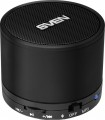The main material used in the construction of the hull.
—
Plastic. Inexpensive and at the same time very convenient material for portable acoustics. Plastic easily accepts a variety of colours and complex shapes; the latter not only gives space to designers, creating
speakers of unusual design, but also allows you to apply various tricks to improve sound quality. In addition, this material is not afraid of moisture. It is believed that the strength of plastic is not very high, but this disadvantage is easily compensated by the large thickness of the material or the use of special impact-resistant grades. Therefore, plastic is found in all categories of speakers, from low-cost to high-end and from "home" to extreme, designed for an active lifestyle and frequent outdoor use.
—
Metal. The metal gives the speakers a solid and expensive appearance, and on the practical side, this material is remarkable primarily for its high strength. At the same time, it is much more expensive than plastic — also due to the fact that manufacturers have to use shock-absorbing inserts and other tricks to avoid an unpleasant "metallic" coloration of the sound; and the mentioned strength is most often not critical. Therefore, metal cases are much less common than plastic cases, mainly in rather expensive portable acoustics.
— Silicone. Relatively soft and elastic mate
...rial, not afraid of moisture. Suitable for creating dust, moisture and shock-proof speakers; in addition, it is convenient for models with suction cups (see above) — the part of the body that has the appropriate shape can play the role of a suction cup directly. At the same time, silicone has no other noticeable advantages over plastic, so its use is limited to specific models of portable acoustics.
— Rubber. For a number of reasons, rubber is considered well suited for models with dust and water protection, almost all speakers made of this material are protected. In addition, due to the softness of the rubber provides good shockproof properties.
— Wood. Wood is considered the optimal material for speaker cabinets in terms of acoustics. However, the specificity of portable speakers is such that this moment is not decisive in this case, and the main advantage of wooden cases over others (primarily plastic ones) is their aesthetic appearance, with characteristic colours and patterns. In addition, many consider wood a more pleasant to the touch and “natural” material. But this option does not have any special practical advantages, despite the fact that it is quite expensive. As a result, portable speakers with wooden cases are rare — they are mostly designer models created based on the original design.
